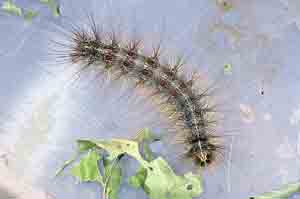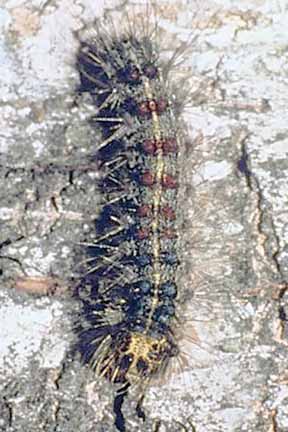Gypsy Moth | |
|---|---|
| June 9, 2008 | |
|
Gypsy moth caterpillars are making themselves known in northern Illinois. We have reports of caterpillars ranging from 3/4 to 1-1/2 inches long. The larval numbers are high enough in several areas of DuPage County and other areas that they are causing major defoliation. These half-grown caterpillars are making themselves known when they move from one tree to another looking for additional food. Gypsy moth overwinters in the egg stage, hatching out at saucer magnolia, Magnolia x soulangiana, petal drop. This coincides with bud break to early leaf expansion on many oak species, probably the gypsy moth’s favorite host. Larvae are susceptible to insecticidal control beginning at bloom of bridal wreath spirea, Spiraea x vanhouttei. The hairy caterpillars are dark colored in lightly infested areas, tan in heavy infestations. Illinois infestations, although heavy in our experience, are still light enough to be composed of dark-colored caterpillars. When young, the caterpillars have a row of orangish spots down their back with smaller white markings alongside. Half-grown and older caterpillars have a double row of blue and then red balls down the back. Fully grown caterpillars approach 2 inches in length.  Gypsy moth young larva. The caterpillars eat the leaves from the margins inward, leaving only the midvein in heavy infestations. They feed on a wide range of trees, including oak, maple, poplar, willow, crabapple, birch, linden, white pine, and spruce. They are most numerous at the top of the tree, working their way down as foliage is consumed. They feed primar-ily at night when they are young, but older caterpillars feed day and night. The caterpillars in heavily infested trees produce a rain of feces onto those who walk underneath. When molting between instars (stages), the caterpillars descend lower onto the tree trunk, returning to the foliage after molting. This results in patches several inches in diameter on the trunks consisting of silk webbing and cast skins (exuviae) from the caterpillars.  Gypsy moth mature larva on maple. When fully grown, the caterpillars descend from the trees to search for a protected area to pupate. In light infestations, these larvae tend to pupate beneath flakes of bark. In heavy infestations, these areas become occupied quickly, and huge numbers of caterpillars crawl across the ground and pavement looking for pupation sites. This behavior greatly upsets residents due to the caterpillars’ crawling up the walls of buildings, over lawn furniture, and covering streets and sidewalks. Pupation should occur by the end of June, with moths emerging in July. Male moths are brown with black V-markings on the wings. They have a 1-1/2-inch wingspan and are excellent fliers. Female moths are too heavy-bodied to fly. They are whitish, with a 2-inch wingspan. They also have black V-markings on the wings. It is common to see male gypsy moths flying constantly around trees containing large numbers of females. Female moths typically crawl only a short distance from their pupal cases before mating and laying their eggs. Egg masses containing up to 1,000 eggs are about 1 inch long by 1/2 half inch wide and covered with the tan hairs of the female moth’s underside. These eggs overwinter and hatch the following spring. As long as caterpillars are feeding, insecticide applications can be made. However, insecticides are more effective against younger caterpillars. Recommended insecticide sprays include Bacillus thuringiensis kurstaki (Dipel, Thuricide), diflubenzuron (Dimilin), tebufenozide (Mimic), and spinosad (Conserve). Emamectin benzoate is also very effective as a trunk-injected insecticide against gypsy moth caterpillars. It recently received a state label as Tree-Age, mainly for control of emerald ash borer. | |
| Author: | Phil Nixon |
